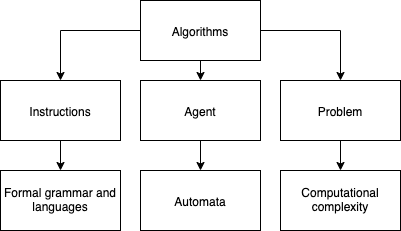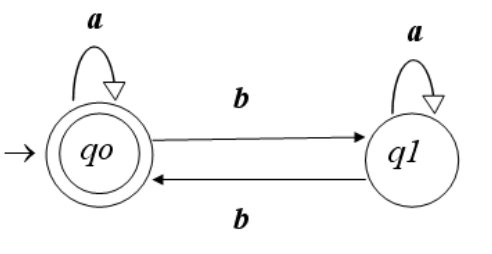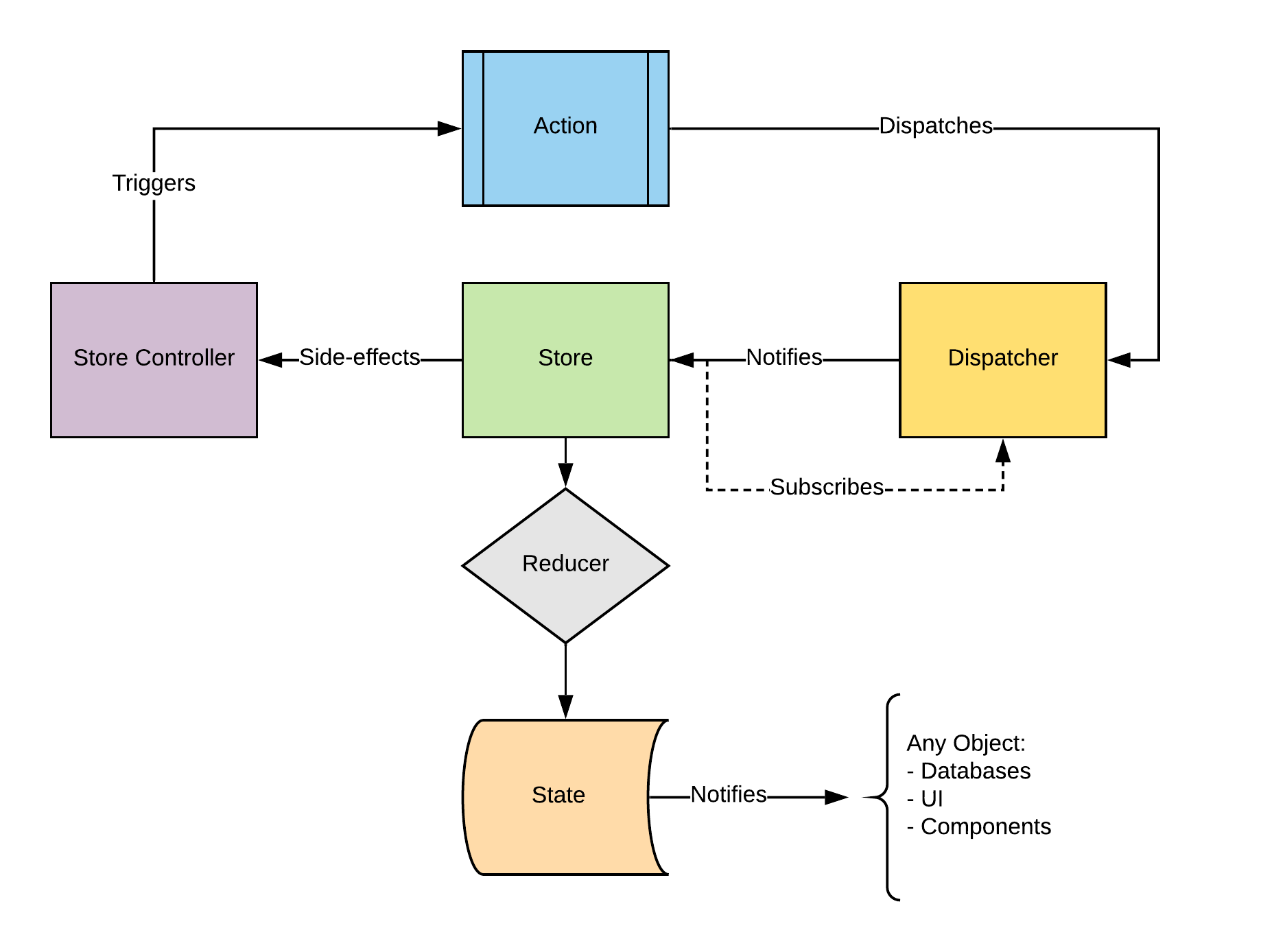About State Machines on iOS Development.
In Computer Science we get introduced to the formal computational perspective to know what can (and what cannot) a computer do.
For this purpose we utilize mathematical tools, like logic and linguistics, formalize the problem resolution methods and obtain abstract languages models, from computers and from computing processes.
History
- Maths and logic, in the 30’s, Gödel, Turing, Church… Stablishes the fundamental boundries of computational calculus.
- Engineering, in the 30’s and 50’s, Shanonn. Formalization of sequential circuits of finite state machines.
- Linguistics, in the 50’s, Chomsky. Formal specification of languages and its grammar and hierarchy.

Graphs
Defined as a schema with nodes {V} and edges R⊂V×V.
- Arc: oriented edge
(vi, vj) - Loop: edge with a single node
(vi, vj) - Precedent (of a node
v): is anotherviwhich(vi,v)∈R - Next (of a node
v): is anotherviwhich(v, vi)∈R
Useful to represent state machine and automata
Finite automata
- Deterministic finite automata (DFA)
- Non-deterministic finite automata (NFA)
- Finite automata with empty transitions (NFA-ε)
Automata
Is a mathematical model that can be applied to:
- Electromechanical machines
- Digital circuits
- Processes and sequencial systems
- Decision algorithms
- Lexical analysis
- Search
- Commmunication protocols
- …
We’re going to focus our attention on DFAs, which has a formal representation of A = (∑, Q, f, qo, F).
It is a quintuple formed by:
∑= Input alphabet.Q= Set of (finite and not empty) states.f= Transition functionf : Q × ∑ → Q.f(state, symbol)=state<- only one!q0 ∈ Q= Initial state.F ⊆ Q= Set of final states.
They are represented in tables or graphs.
- Example:
Ej. A=( {a, b} , {q0, q1} , f , qo, {qo} )
Table
| f | a | b |
|---|---|---|
| ->*q0 | q0 | q1 |
| q1 | q1 | q0 |
Graph

Automata and words
Given a function f, it can be expanded to a chain of symbols such as:
f : Q × ∑*→Qf (q, ε) = qf (q, aw) = f ( f(q, a), w)
DFA’s associated language
Chains which are used by the automata to reach from f0 to a final state.
L(A) = {w∈∑* / f(q0, w)∈F}
Regular languages
Any set of chains (above a closed alphabet) which can be represented by:
- An automata
- A regular expression
- A regular grammar
So: {L(AF)} = {L(ER)} = {L(G3)}
We’re going to skip what is a regular expression because it scapes from the article’s scope, nevertheless we can deduce that automata ≡ regular expression.
Why?
- Analysis theorem of Kleene
- Synthesis theorem of Kleene
Turing’s machine
In a short description it is a transformation between an input and an ouput. Mental’s process model (algorithmic).
Formal definition
M = ( ∑, Γ, #, Q, q0, f, F)
∑Machine’s alphabetΓRecord’s alphabet# ∈ ΓWhite space (empty section) that#∉∑QFinite set of statesq0∈QInitial statefTransition partial function.f: Q × Γ → Q × Γ × {R, L}
F⊆QSet of final or stop states.
The behavior is deterministic
Turing’s machine in applied software development.
We aim to apply a known Turing’s machine definition to a computer program, using the Swift language for this purpose.

Why is this relevant to software development?
- We can create a finite number of states and transitions between them so we can expect a Turing’s machine, so we can assume that our application’s behavior is deterministic.
Mini
During my work in BQ, we have developed a library which, with this ideas in mind, can be used in production applications.
During this section, we’re going to explain al the elements in the architecture and how to use it.
State
-
The minimal unit of the architecture is based on the idea of the State. State is, as its name says, the representation of a part of the application in a moment of time.
-
The State is a simple struct which is conformed of different Promises that holds the individual pieces of information that represents the current state, this can be implemented as follows.
-
For example:
struct MyCoolState: StateType, Equatable {
let cool: Promise<Bool>
init(cool: Promise<Bool> = .idle()) {
self.cool = cool
}
}
-
The default inner state of a
Promiseisidle. It means that noAction(see more below), has started any operation over thatPromise. APromiseis the reprensentation of a potential state transition with some kind of data attached with it (or not). -
The core idea of a
Stateis its immutability, so once created, no third-party objects are able to mutate it out of the control of the architecture flow. -
As can be seen in the example, a
Statehas a pair ofTask+Resultusually (that can be any object, if any), which is related with the execution of theTask. In the example above,CoolTaskis responsible, through itsReducerto fulfill theActionwith theTaskresult and furthermore, the newState.
Action
- An
Actionis the piece of information that is being dispatched through the architecture. Anyclasscan conform to theActionprotocol, with the only requirement of being unique its name per application.
class RequestContactsAccess: Action {
// As simple as this is.
}
-
Actions are free of have some pieces of information attached to them, that’s why Mini provides the user with two main utility protocols:CompletableAction,EmptyActionandKeyedPayloadAction. -
A
CompletableActionis a specialization of theActionprotocol, which allows the user attach both aTaskand some kind of object that gets fulfilled when theTasksucceeds.
struct RequestContactsAccessResult: CompletableAction {
let promise: Promise<Bool?>
typealias Payload = Bool
}
- An
EmptyActionis a specialization ofCompletableActionwhere thePayloadis aSwift.Void, this means it only has associated aPromise<Void>.
struct ActivateVoucherLoaded: EmptyAction {
let promise: Promise<Void>
}
- A
KeyedPayloadAction, adds aKey(which isHashable) to theCompletableAction. This is a special case where the sameActionproduces results that can be grouped together, tipically, under aDictionary(i.e., anActionto search contacts, and grouped by their main phone number).
struct RequestContactLoadedAction: KeyedCompletableAction {
typealias Payload = CNContact
typealias Key = String
let promise: [Key: Promise<Payload?>]
}
Store
-
A
Storeis the hub where decissions and side-efects are made through the ingoing and outgoingActions. AStoreis a generic class to inherit from and associate aStatefor it. -
A
Storemay produceStatechanges that can be observed like any other RxSwift’sObservable. In this way aView, or any other object of your choice, can receive newStates produced by a certainStore. -
A
Storereduces the flow of a certain amount ofActions through thevar reducerGroup: ReducerGroupproperty. -
The
Storeis implemented in a way that has two generic requirements, aState: StateTypeand aStoreController: Disposable. TheStoreControlleris usually a class that contains the logic to perform theActionsthat might be intercepted by the store, i.e, a group of URL requests, perform a database query, etc. -
Through generic specialization, the
reducerGroupvariable can be rewritten for each case of pairStateandStoreControllerwithout the need of subclassing theStore.
extension Store where State == TestState, StoreController == TestStoreController {
var reducerGroup: ReducerGroup
ReducerGroup(
Reducer(of: OneTestAction.self, on: self.dispatcher) { action in
self.state = self.state.copy(testPromise: *.value(action.counter))
}
)
}
}
-
In the snippet above, we have a complete example of how a
Storewould work. We use theReducerGroupto indicate how theStorewill interceptActions of typeOneTestActionand that everytime it gets intercepted, theStore’sStategets copied (is not black magic 🧙, is through a set of Sourcery templates that are distributed with the package). -
When working with
Storeinstances, you may retain a strong reference of itsreducerGroup, this is done using thesubscribe()method, which is aDisposablethat can be used like below:
var bag = DisposeBag()
let store = Store<TestState, TestStoreController>(TestState(), dispatcher: dispatcher, storeController: TestStoreController())
store
.subscribe()
.disposed(by: bag)
Dispatcher
- The last piece of the architecture is the
Dispatcher. In an application scope, there should be only oneDispatcheralive from which every action is being dispatched.
let action = TestAction()
dispatcher.dispatch(action, mode: .sync)
- With one line, we can notify every
Storewhich has defined a reducer for that type ofAction.
Advanced usage
-
Mini is built over a request-response unidirectional flow. This is achieved using pair of
Action, one for making the request of a change in a certainState, and anotherActionto mutate theStateover the result of the operation being made. -
This is much simplier to explain with a code example:
// We define our state in first place:
struct TestState: StateType {
// Our state is defined over the Promise of an Integer type.
let counter: Promise<Int>
init(counter: Promise<Int> = .idle()) {
self.counter = counter
}
public func isEqual(to other: StateType) -> Bool {
guard let state = other as? TestState else { return false }
guard counter == state.counter else { return false }
return true
}
}
// We define our actions, one of them represents the request of a change, the other one the response of that change requested.
// This is the request
class SetCounterAction: Action {
let counter: Int
init(counter: Int) {
self.counter = counter
}
}
// This is the response
class SetCounterActionLoaded: Action {
let counter: Int
init(counter: Int) {
self.counter = counter
}
}
// As you can see, both seems to be the same, same parameters, initializer, etc. But next, we define our StoreController.
// The StoreController define the side-effects that an Action might trigger.
class TestStoreController: Disposable {
let dispatcher: Dispatcher
init(dispatcher: Dispatcher) {
self.dispatcher = dispatcher
}
// This function dispatches (always in a async mode) the result of the operation, just giving out the number to the dispatcher.
func counter(_ number: Int) {
self.dispatcher.dispatch(SetCounterActionLoaded(counter: number), mode: .async)
}
public func dispose() {
// NO-OP
}
}
// Last, but not least, the Store definition with the Reducers
extension Store where State == TestState, StoreController == TestStoreController {
var reducerGroup: ReducerGroup {
ReducerGroup(
// We set the state with a Promise as .pending, someone has to fill the requirement later on. This represents the Request.
Reducer(of: SetCounterAction.self, on: self.dispatcher) { action in
guard !self.state.counter.isOnProgress else { return }
self.state = TestState(counter: .pending())
self.storeController.counter(action.counter)
},
// Next we receive the Action dispatched by the StoreController with a result, we must fulfill our Promise and notify the store for the State change. This represents the Response.
Reducer(of: SetCounterActionLoaded.self, on: self.dispatcher) { action in
self.state.counter
.fulfill(action.counter)
.notify(to: self)
}
)
}
}
Documentation
All the documentation available can be found here
Recap
We have described how an automata can be represented in a formal or mathematical way, but it can be used in computed development to make predictable the behavior of a computer application.
Why is this possible? Because given a state A and we want the application to be in a state B we can only execute an action X which makes A - X -> B and there is no other action in the application to reach this goal.
For record, we can log every state and action change in the application and rewind all the effects to reach the initial state named A.
This kind of behavior makes predictable that every user interaction which produces and action and, therefore, a state change in the application is deterministic and cloned in any further environment with the same semantics.